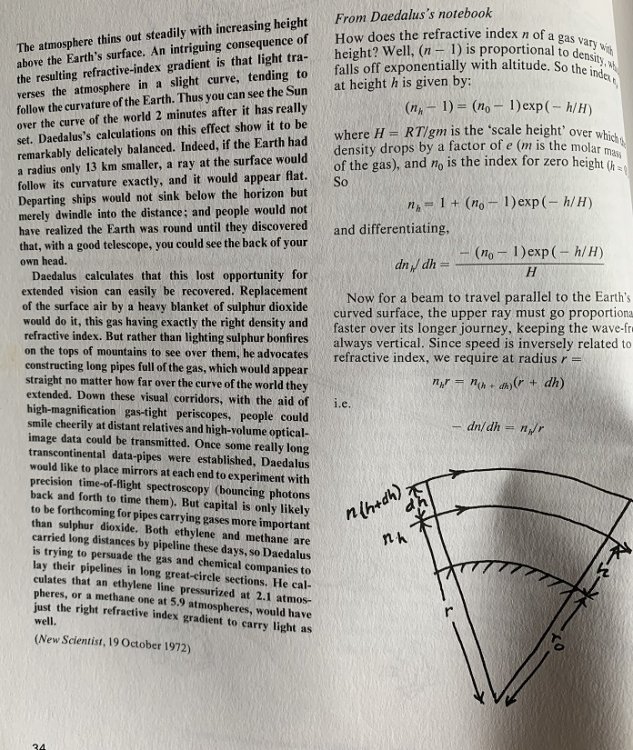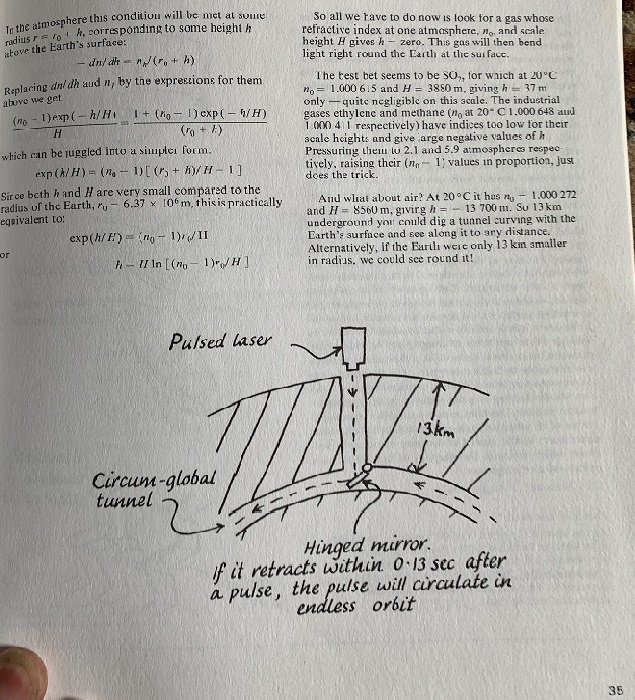

John Cuthber
Resident Experts-
Posts
18413 -
Joined
-
Last visited
-
Days Won
52
Content Type
Profiles
Forums
Events
Everything posted by John Cuthber
-
It is also why pressure vessel testing is done with liquids (usually water) rather than gas. Fundamentally, the idea depends on having a large "cold body" that you can use for cooling. And if you have that, you can use it to run a "stream engine" with, for example, butane, as the working fluid.
-

What is the size and shape of single optical photon?
John Cuthber replied to Duda Jarek's topic in Physics
Nice graph. But the y axis is electric field strength, not "height", so you can't say that the photon has a width. You would be saying something like the width is "x volts per meter". Does that help in any way? -
Even if the answer was "it's marginal" (Let's be clear; it is not marginal because the vaccine is way safer) then they should take the vaccine. It's a good idea not to spread diseases. Partly because it's antisocial. Partly because the more people get the virus, the more likely it is that the virus will mutate into something that does do lots of harm to the under 50s.
-

The Greatest Laser Experiment In History - FECORE
John Cuthber replied to Dr. Zack's topic in Speculations
I wonder if Sandor will come back. -

Isolated rotating unbalance. Why is there a vibration?
John Cuthber replied to John2020's topic in Speculations
In the absence of any constraints (for example, if it was floating in space), if you start the system up (say, by remote control) the rotor will spin one way, and the stator (and power supply etc) will spin the other. An ant sat on the battery will see the stars moving and will deduce that he's spinning. Another ant on the mass "m" will make the same observations and deductions. If you let them communicate they will be able to establish that they are rotating in opposite directions around the same axis. Neither of them will think they are vibrating. Meanwhile back on Earth I can watch the tip of the second hand of the clock as it goes round. It's going more or less horizontally left to right 15 seconds later it's going straight down. Another 15 seconds and it's moving right to left and another 15 seconds and it's going vertically up. But it isn't normal to think of that as the sum of a left to right, and up and down motion. It's going round in a circle. On the other hand, going round in circles is just one option. if you can vary the phase and frequency of the L-R and U-D vibrations independently, you acn get pretty patterns. https://en.wikipedia.org/wiki/Lissajous_curve None of this is rocket science. -

New Hubble Data Breaks Scientists’ Understanding of the Universe
John Cuthber replied to nec209's topic in Science News
"New Hubble Data Breaks Scientists’ Understanding of the Universe" That's what research is for. It's called progress. However, my guess is that the headline is misleading. -

How much pressure do you need to make air go near lightspeed?
John Cuthber replied to pewguin's topic in Classical Physics
Or one atmosphere if the temperature is high enough. In normal circumstances, air molecules travel at about the speed of sound (that's not a coincidence) If you want them to travel near the speed of light, that's about a million times faster (give or take) That means you need to increase their energy a million million times (because the energy varies as the square of the velocity) And the average energy is proportional to temperature. So you need to heat them up from about 280K to about 280,000,000,000,000 K I think that's about 10,000 times hotter than a supernova. -

What type of scientist creates anti-venoms?
John Cuthber replied to chrismackey1972's topic in Other Sciences
I think it's typically a horse that produces antivenoms. -

The Greatest Laser Experiment In History - FECORE
John Cuthber replied to Dr. Zack's topic in Speculations
Al they are saying is that, to a rough approximation, the deviation is roughly proportional to the square of the distance over which the light travels. They are approximating the curvature by a parabola. It's not a desperately bad approximation. Inches per mile squared is an odd unit, but ... But their claim that air is homogeneous is ,wrong, only slightly, but nevertheless, wrong. And by an interesting coincidence, the effect almost exactly cancels out the curvature of the Earth. Which explains their experimental results (without resorting to stupid stuff like a flat Earth). -

The Greatest Laser Experiment In History - FECORE
John Cuthber replied to Dr. Zack's topic in Speculations
Actually, that's the parabolic approximation to the curve. But it's not the point. Do you accept that the air is thinner at altitude and will therefore have a lower refractive index? -

The Greatest Laser Experiment In History - FECORE
John Cuthber replied to Dr. Zack's topic in Speculations
Did you notice that I put the word "denser" in quotes? And that's the lie: the claim that the air is homogeneous, when we know that it gets less dense as you go up. Here's the first page of the explanation from the 70s And here's the second page -

The Greatest Laser Experiment In History - FECORE
John Cuthber replied to Dr. Zack's topic in Speculations
As I said, I'm trying to track down a reference from this https://www.google.co.uk/books/edition/The_Inventions_of_Daedalus/0Xt2QgAACAAJ?hl=en What I disagree with is the idea that they think it is appropriate to publish stuff that is obviously wrong. The essence of the point is simple. As they say, a alight beam will bend towards a "denser" medium (one with a higher refractive index). Imagine a beam of light shining horizontally as in their experiment. Eventually, if it didn't hit anything, it would go over the horizon and into space, But clearly "space" has a much lower density. So the light beam is bent towards the denser medium, i.e. the beam bends downwards. It's not a big effect, but nor is the curvature of the Earth. The book includes a couple of interesting calculations. One is that, if the earth was a bit smaller, the gravitational gradient would be a bit steeper and the curvature would be a bit more, and light would actually go all round the earth by refraction. The other is that, if you used a slightly more refractive gas - They suggested sulphur dioxide- the curvature would match that of the earth's surface. That would mean that light shone into a tube full of SO2 would go round the world. Now, I recognise that the predicted effect would only completely cancel the effect of the Earth's curvature if the planet was a bit smaller. But the effect we do get will cancel out most of the curvature. So their insistence on 8 inches per mile squared is simply wrong. And, by now, it's fair to assume they know it. Incidentally, at about 2 minutes in to the video, they point out that they are a not-for-profit organisation. That doesn't stop them claiming expenses. And I guess that's why they are ignoring physics that was widely published decades ago. -

The Greatest Laser Experiment In History - FECORE
John Cuthber replied to Dr. Zack's topic in Speculations
I watched the first 20 minutes, at which point they said something that's plainly wrong (so I stopped watching). I will try to dig out an interesting reference from Daedalus about it. -

What is the size and shape of single optical photon?
John Cuthber replied to Duda Jarek's topic in Physics
If I want to measure the length of a table, the fist thing I need to do is define the edge of the table. Does a photon have an edge? -

Balancing a pools pH with Boron in the water
John Cuthber replied to NotYou's topic in Inorganic Chemistry
Yes it will. -
Sorry, I hadn't realised how far into the realms of fantasy you were. I misread the 294 as 284. I have a theory that it twill turn out that the only way to get the 294 isotope is by bombarding unobtanium with unicorn droppings. as you say...
-
It has a measured half life of 0.098 seconds. Observation trumps "theory".
-
The most stable known isotope, copernicium-285, has a half-life of approximately 28 seconds.
-

Balancing a pools pH with Boron in the water
John Cuthber replied to NotYou's topic in Inorganic Chemistry
Have you added any boron/ borate to the water? If not, then there's probably not enough to make much difference. -

hijack redux from Magnetically levitated wheels
John Cuthber replied to Bill McC's topic in Trash Can
Interesting. In answering the OP's question as if it only applies to this bike you seem to have introduced some of your trademark nonsense -
Six years on this may be a rhetorical question but... Have you ever tried to steer a hovercraft? There's a reason why they use this sort of thing for trains, and the reason is rails. Magnetic bearings are useful at high speeds and when you want to ensure that grease doesn't get anywhere you don't want it. Neither criterion applies to bikes. The other reason to add absurd bearings to a bike would be so you could add an absurd fee to the price tag.
-

Safety and feasibility of driverless vehicles
John Cuthber replied to studiot's topic in Science News
You might want to revise your opinion. https://en.wikipedia.org/wiki/Docklands_Light_Railway The only accidents in its 33 year history resulted from human action. -

What would be the result of raising the pressure of tritium
John Cuthber replied to Giglap's topic in Inorganic Chemistry
I assume he means this https://en.wikipedia.org/wiki/Tritium_radioluminescence Eventually the T pressure would be high enough that the gas would stop most of the beta particles reaching the phosphor. On the pother hand, by that point it might be acting like this https://en.wikipedia.org/wiki/Deuterium_arc_lamp There would also be a point where the energy density would be so high the glass would melt. And, if you really worked at it,. you would get nuclear fusion. You could get more power per gram by using something with a shorter half life or a higher emission energy (or both). -
If this happened, how come my dad never mentioned it?



